Related Research Articles
The Ulster Defence Regiment (UDR) was an infantry regiment of the British Army established in 1970, with a comparatively short existence ending in 1992. Raised through public appeal, newspaper and television advertisements, their official role was the "defence of life or property in Northern Ireland against armed attack or sabotage" but unlike troops from Great Britain they were never used for "crowd control or riot duties in cities". At the time the UDR was the largest infantry regiment in the British Army, formed with seven battalions plus another four added within two years.

The East Tyrone Brigade of the Provisional Irish Republican Army (IRA), also known as the Tyrone/Monaghan Brigade was one of the most active republican paramilitary groups in Northern Ireland during "the Troubles". It is believed to have drawn its membership from across the eastern side of County Tyrone as well as north County Monaghan and south County Londonderry.

Thiepval Barracks is a British Army barracks and headquarters in Lisburn, County Antrim.
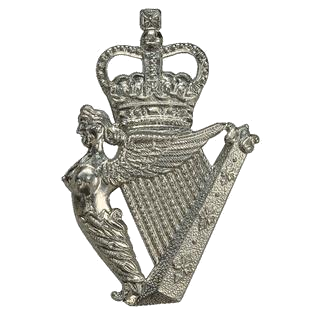
The Royal Irish Regiment is an infantry regiment of the British Army. The regiment was founded in 1992 through the amalgamation of the Royal Irish Rangers and the Ulster Defence Regiment. Their oldest predecessor, the 27th Regiment of Foot, was first raised in June 1689 to fight in the Williamite War in Ireland. Other notable regiments in their lineage include the Royal Inniskilling Fusiliers, Royal Irish Rifles and the Royal Irish Fusiliers.
The Duke of Edinburgh's Royal Regiment (Berkshire and Wiltshire) was an infantry regiment of the British Army.

The Queen's Own Highlanders (Seaforth and Camerons), officially abbreviated "QO HLDRS," was an infantry regiment of the British Army, part of the Scottish Division. It was in existence from 1961 to 1994.
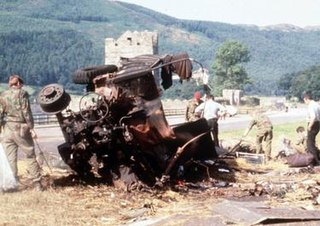
The Warrenpoint ambush, also known as the Narrow Water ambush, the Warrenpoint massacre or the Narrow Water massacre, was a guerrilla attack by the Provisional Irish Republican Army (IRA) on 27 August 1979. The IRA's South Armagh Brigade ambushed a British Army convoy with two large roadside bombs at Narrow Water Castle outside Warrenpoint, Northern Ireland. The first bomb was aimed at the convoy itself, and the second targeted the incoming reinforcements and the incident command point (ICP) set up to deal with the incident. IRA volunteers hidden in nearby woodland also allegedly fired on the troops, who returned fire. The castle is on the banks of the Newry River, which marks the border between Northern Ireland and the Republic of Ireland.
The proxy bomb, also known as a human bomb, is a tactic that was used mainly by the Provisional Irish Republican Army (IRA) in Northern Ireland during the conflict known as "the Troubles". It involved forcing people to drive car bombs to British military targets after placing them or their families under some kind of threat The tactic was later adopted by the FARC in Colombia and by rebels in the Syrian Civil War.
Events during the year 1974 in Northern Ireland.

Palace Barracks, Holywood is a military installation and the Northern Ireland headquarters of MI5, in Holywood, County Down, Northern Ireland.
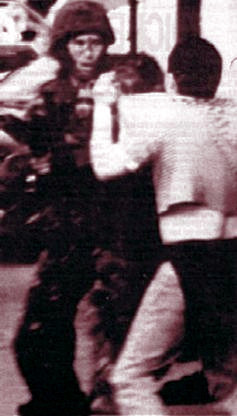
The 1992 Coalisland riots were a series of clashes on 12 and 17 May 1992 between local Irish nationalist civilians and British Army soldiers in the town of Coalisland, County Tyrone, Northern Ireland. The Third Battalion 1992 tour's codename was "Operation Gypsy".
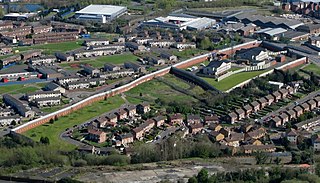
The Battle at Springmartin was a series of gun battles in Belfast, Northern Ireland on 13–14 May 1972, as part of The Troubles. It involved the British Army, the Provisional Irish Republican Army (IRA), and the Ulster Volunteer Force (UVF).
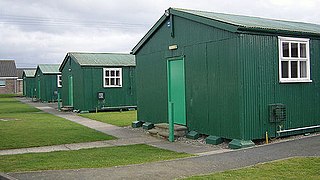
Abercorn Barracks, sometimes referred to as Ballykinlar Barracks or Ballykinler Barracks, is a former military base in Ballykinler in County Down, Northern Ireland. The surrounding training area is retained by the Ministry of Defence.

Inglis Barracks was a military installation in Mill Hill, London, NW7. It was also referred to as Mill Hill Barracks. The site has been redeveloped and now contains a variety of modern housing.

In the Ballygawley land mine attack of 13 July 1983, four soldiers of the British Army's Ulster Defence Regiment (UDR) were killed by a Provisional Irish Republican Army (IRA) land mine near Ballygawley in County Tyrone, Northern Ireland. The soldiers were travelling in a convoy of armoured vehicles when the land mine was detonated remotely.
On 9 April 1990, the South Down Brigade of the Provisional Irish Republican Army (IRA) detonated a massive improvised land mine under a British Army convoy outside Downpatrick, County Down, Northern Ireland. Four soldiers of the Ulster Defence Regiment (UDR) were killed, the regiment's greatest loss of life since 1983.
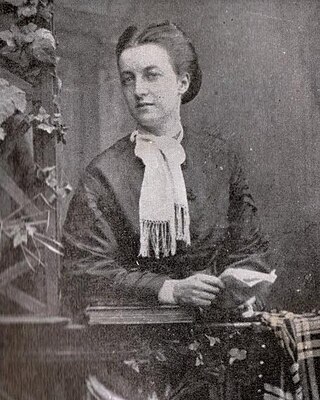
Elise Sandes was the founder of a welfare movement for soldiers that bears her name and still survives today. She was an evangelical Christian and philanthropist and her concern for a young soldier in Tralee in the late 1860s led her to set up a centre for soldiers' recreation and general welfare. By 1913 there were thirty-one such 'soldiers' homes' all situated in the vicinity of various army barracks; twenty-two were in Ireland and the rest in British India. It is widely regarded that Sandes Homes for Soldiers were very well run and filled a real need among young soldiers, often far from their families who were made to feel at home and not faced with the cold commercial atmosphere of the barracks canteen. Sandes believed that a good feminine influence met a real need where young soldiers were concerned, and the 'homes' were the only place where some of the young recruits could receive anything approaching motherly care.
This is a timeline of the events and actions during the Troubles that were carried out in Great Britain, the vast majority of which were carried out by Irish Republican paramilitaries mainly the Provisional IRA were by far the most active but both the Official IRA and the Irish National Liberation Army, also carried out a number of attacks, which included bombings and shootings. Ulster Loyalist paramilitary groups also carried out a small number of violent actions.
References
- ↑ "Sutton Index of Deaths, 1974". Conflict Archive on the Internet (CAIN). Retrieved 31 August 2006.
- ↑ "Duke of Edinburgh's Royal Regiment". Palace Barracks Memorial Garden. Retrieved 25 January 2010.
- ↑ "The bombing of Sandes Soldiers Home, Ballykinler". 1st Bn Duke of Edinburgh's Royal Regiment. Farmersboys.com. 19 July 2006. Archived from the original on 21 April 2012. Retrieved 5 December 2023.